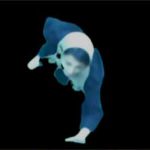Elephant in the dark
A multimedia and interactive installation including 3D objects, video arts, electronic buttons and woods.
Year: 2023
As a multidisciplinary artist, I have been inspired by literature in most of my works. Words can help you hear the sound of music, feel the scent of a flower, or see a spectacular scene between the lines of a story.
The elephant in the dark is one of the most celebrated poems of Masnavi-Manavi (a combination of six books) by Rumi. The book is one of the most influential works in Sufism and mysticism. It is a spiritual text that helps Sufis to find their way of being sincerely in love with God.
In this story/poem, Rumi includes multiple points of view, inviting the reader to fall for enchantment and mysticism. It is about the exhibition of an elephant in a dark house where people who have never confronted an elephant in real life collected there to express their understanding of this creature by only touching it. Each person enters separately and can only feel a part of the elephant. In the end, the story reveals different layers of comprehension. Rumi is the Sufi teacher who, by telling stories, helps clarify a statement.
To me, the image that Rumi has created here in this story is spectacular. A giant, friendly, and clever creature patiently bears with the people getting closer and touching its body, yet stands still for them to explore. Although the elephant’s patience might not have been a dominant factor in his mind, it remains a bold image that Rumi created to teach a lesson. With this multimedia installation, I am creating a contemporary scene of that image.
The goal of this literature-based installation is to cultivate the hidden curiosity of each individual and engage them with the concept of seeing and exploring. Even if we know that we have already seen an elephant as a giant creature a million times, there is still this wish to understand more about them, see them from a different angle, and maybe listen to their voices.
In this interactive installation, I juxtapose classical literature with contemporary artwork to find a connection between mysticism and rationality.
The main factor in the original story that helps to follow the tale is the use of only one of the five senses (touching).
There are buttons on each of the three screens. Each of these 3D-shaped signals exposes a part of an elephant (Tusk and trunk, Ears, and feet). By touching each of these buttons, the screen turns on for a few seconds, and the audience can see a close-up image of an elephant. With that in mind, I invite the visitors to act and observe. They might see a different part of the elephant each time they touch-push the same button. It may lead them to think twice about their feelings. Do we always need to trust our senses? Or do we have to change our perspective toward our perception of things? These are the questions that might come into the mind of the visitors. Both the images and the sounds motivate the audience to explore more.
The apertures on the wall are contrived to limit the vision of the visitors to an extent in which they understand they are missing some part of the view. It is pleasant to curb the sight for some details, but if they want a larger view, they may walk to the back of the screen. By walking at an immediate distance from the large screen, the visitors understand that they are too close to the image to picture an utter scene.
At the end of the original story, Rumi explains if we could bring a candle with us or enter together, we could have a more realistic understanding of the creature.
In this installation, the visitors have their candles in hand and can enter together. All that considered, they have more tools in hand to explore the whole image.
















